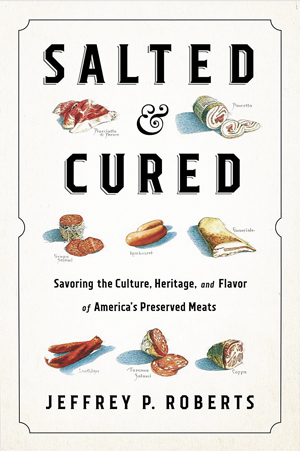Preserving Heritage
New book by Jeffrey Roberts explores cured meat
Approach any upscale deli and the plethora of cured meat products available by the slice or the chub will delight the senses. American made salumi, dry cured ham, smoked sausages and other specialty meats have experienced a renaissance similar to craft cheese.

As consumers become savvier about the source and production of their favorite foods, producers of finely cured meats have taken up the challenge, offering options harkening to an earlier time in the American food scene, when preservation was a way of life.
“Salted and Cured: Savoring the Culture, Heritage and Flavor of America’s Preserved Meats” (Chelsea Green, 2017) is the most recent work by writer and food historian Jeffrey P. Roberts, author of “The Atlas of American Artisan Cheese” (Chelsea Green, 2007). The adage about not wanting to see how the sausage is made doesn’t apply to this book.
His latest tome traces the history of meat preservation in America, from the colonial period through waves of immigration that brought regional specialties to the New World and onward to the latest generation of farmers, chefs and charcutiers, continuing the age-old tradition.
The book masterfully weaves together archaeology, history, gastronomy and the march toward rich, sustainable and diverse culinary experiences. The humble hog sits at the center of the narrative and humans’ interaction with our porcine friends forges the bedrock of the story.
Archaeologists list pigs as the first domesticated food animal, appearing between 12,000 and 15,000 years ago in the Fertile Crescent. Their astounding adaptability, rapid reproduction and maturation rates have made them a dietary staple in a wide range of cultures for at least 5,000 years.
The word “cure” originates from the Latin “curare,” translating to “to take care of.” Various cultures used different methods, from salt curing to air drying in arid climates, and freeze drying in colder regions. Cured hams were definitely in fashion by Roman times when prosciutto was on the menu for the aristocracy in both crudo and cotto — raw and cooked — varieties.
Hogs made their way to the Americas via early explorers who brought the animals, leaving them at various stops along the way. They would quickly naturalize, becoming a food source for subsequent expeditions.
Roberts’ book traces this timeline and the various regional specialties that evolved from the bounty in focused chapters recounting the history of cured meats, both past and present, throughout the U.S. While the early variations, like the 18th century “barreled pork” trade — literally, pork pickled in brine-filled barrels for ease of transport - were more about sustenance than savoring.
The story becomes decidedly more complex and tasteful as immigrants introduced regional preservation techniques to the expanding country. German wurst, French boudin, Italian prosciutto and salumi are just a few of the traditions that fed American obsession with cured meats on the menu at local butchers and restaurants.
Many of the multi-generational producers remaining in business are celebrated throughout the book alongside a new generation of entrepreneurs who have challenged, with astonishing results, the commodification impulses of our food system.
Though the East Coast and Midwest command the lion’s share of the book, the West Coast represents with iconic Portland producers Higgins Restaurant, Old Salt Marketplace and Olympia Provisions in the “Pacific Rim” chapter, showcasing our local flavor. For my own porcine research, I looked to Portland-based Chop Butchery & Charcuterie inside City Market and The Beautiful Pig of Longview, Washington. Both create excellent examples of craft products that complement cheese selections and easily stand on their own merits.
The book proves to be a fascinating and well-researched look at a subject on which few of us are familiar. It’s ideal for the reading list of anyone wanting to dive deep into the evolution of American preserved meats. The butchers and restaurants profiled in various cities are documented in a handy chapter-by-chapter list, making it an ultimate, meat-centric travel guide for the curious gastronaut.











